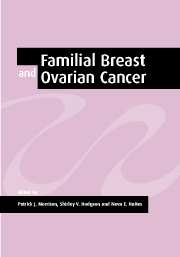Book contents
- Frontmatter
- Contents
- List of contributors
- Foreword by Helena Kennedy
- Preface
- Acknowledgements
- Part 1 Molecular biology and natural history
- Part 2 Screening
- Part 3 Management
- 15 Management of BRCA1/2 mutation carriers
- 16 Management of familial ovarian cancer
- 17 Prophylactic mastectomy in mutation carriers
- 18 Psychosocial aspects of genetic counselling for breast and ovarian cancer
- 19 BRCA1/2 testing: uptake and its measurement
- 20 Breast cancer genetics: ethical, social and insurance issues
- 21 Gene therapy for breast and ovarian cancer
- 22 Future directions
- Index
19 - BRCA1/2 testing: uptake and its measurement
Published online by Cambridge University Press: 24 August 2009
- Frontmatter
- Contents
- List of contributors
- Foreword by Helena Kennedy
- Preface
- Acknowledgements
- Part 1 Molecular biology and natural history
- Part 2 Screening
- Part 3 Management
- 15 Management of BRCA1/2 mutation carriers
- 16 Management of familial ovarian cancer
- 17 Prophylactic mastectomy in mutation carriers
- 18 Psychosocial aspects of genetic counselling for breast and ovarian cancer
- 19 BRCA1/2 testing: uptake and its measurement
- 20 Breast cancer genetics: ethical, social and insurance issues
- 21 Gene therapy for breast and ovarian cancer
- 22 Future directions
- Index
Summary
Introduction
From the time that a family is informed of the identification of a BRCA1/2 mutation, every individual in that bloodline has, in theory, the opportunity to have a genetic test. Each person has the option to have counselling and can choose to have the test, to postpone the decision, or to take no action. The issues that affect this decision and the potential personal sequelae are discussed elsewhere, and are different for men and women.
In the simplest terms, the level of uptake of a test is the number of family members who opt for testing divided by the number of people in the bloodline. The ideal measurement of uptake would involve contacting all family members, and offering counselling and testing. However, in routine clinical practice, family members unknown to clinic are not informed out of the blue about their risk or invited to attend.
This practice respects the confidentiality of patients, and avoids the potential for unexpected anxiety, but anecdotal accounts from the Huntington's disease experience suggest that neither the direct approach nor a non-interventionist course is appropriate for everyone. This also leaves questions about the group of family members not known to clinicians. These are the hardest to quantify because it is impossible to know whether they know about the test and have made an informed decision not to attend clinic, or whether they are unaware of either their family history or the availability of a predictive test.
- Type
- Chapter
- Information
- Familial Breast and Ovarian CancerGenetics, Screening and Management, pp. 306 - 338Publisher: Cambridge University PressPrint publication year: 2002



